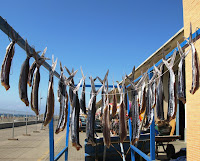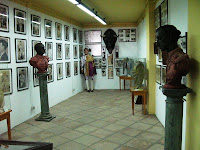
Getting Ready
Getting Started
“Volaores”
The Estepona Bullring and the Four Museums




Lunch at La Escollera
Town Centre Itinerary



Bidding Farewell to the Sea
Travel Tips and Useful Links
What to do: If you want to visit the Corominas archaeological site, you should make an appointment in advance. The staff at the town museums told me it was worth it, as it had been carefully reconstructed –one of Estepona’s must-sees. The contact phone number is +34 654 711 715 and the contact person is Ms Victoria Infante. Ticket prices: €3 for small groups (less than 10 people); €2 for large groups (more than 10). Mail: info@acudeestepona.com.
Other things to see: If you’re interested in animals and nature, then Selwo Aventura is your place. Created ten years ago, Selwo Aventura is a nature park where animals are reared in semi-captivity. It’s become one of the leading centres of its kind in Europe. Elephants, tigers, giraffes, lions, bears, birds of prey… Moreover, you can stay in the park for the night. (Contact phone number: +34 902 190 482). Parque de San Isidro Labrador or Los Pedregales is the ideal place for a family outing in contact with nature. There’s a camping area, a playground for children, a man-made lake, a bar and restaurant, several barbecues, and other facilities. Estepona’s star, however, is Los Reales de Sierra Bermeja, a balcony overlooking the Mediterranean and a unique place from the point of view of its flora –the native Spanish fir was first discovered here– and its geological features. Estepona shares this nature park with Casares and Genalguacil. For further information on it, go to our blog entry 11. Genalguacil: A Living Museum. Finally, there’re seven watchtowers facing the sea in Estepona. They were used to detect attacks from North African pirates or the Turks. They all date back to the fifteenth-century; some are better kept than others.
Useful links: You can use the website of the Costa del Sol Tourist Board as your point of reference, which is what we usually do. The Estepona Town Hall website also contains useful information. Finally, in Estepona Imágenes you can find many interesting visual contents (mainly images).
Comments, suggestions, and opinions from travellers/ visitors to this blog are very welcome. This is intended to be an open door, so the more things shown and said, the better. See you under the Bright Blue Sky.
21 ESTEPONA: THE OCEAN’S REFLECTION IN HISTORY
Tuesday, 29 September 2009
Posted by Israel Olivera at 00:01 0 comments
20 BENARRABÁ: OLD CRIMSON
Tuesday, 22 September 2009
His name was Abdelselam ben Arrabat, and he was a member of the guild of dyers in the Banuh Rabbah tribe. They would say he was an alchemist, his complicated formulas magically changing the colours of the fabrics manufactured in Valle del Genal. Stones, plants, earth, animals, insects were the ingredients in his magic potions. After several essays, he once came up with a bright colour resembling blood. He called it “qarmazi,” i.e. “crimson,” keeping its formula secret until he died. After his death, one of his sons revealed the secret: the colour came from a scale insect called “qarmaz,” who profusely sucked other animals’ blood. All this blood dyed the threads in the clothes of old Benarrabá’s inhabitants.
Getting Close
Point and Shoot
Benarrabá boasts remarkable tokens of domestic architecture. Many eighteenth-century houses have come down to us, keeping elements from a distant Arab past: guardapolvos (protruding eaves protecting passers-by from the rain), adarves (patios common to several houses and connecting them to the street), bocatejas (the first tile in each row), and algorfas (from al-gurfa in Arabic, a room in the attic used to store corn). The Benarrabá Town Hall website, http://www.benarraba.es/a.es/, contains a tour of the streets and houses featuring these traditional architectural elements. Take note of their street numbers and be ready to travel back to faraway times.
The Chapel of Vera Cruz

The Town Centre and the Church


Farewell
Following a good friend’s advice and knowing this was a pork producing area, just like the neighbouring town of Algatocín, I bought some meat packs and half a loaf of bread –€5. I sat down in a corner to savour my loot, knowing that many men and women have tasted these very same foods before me. What else could I ask for? After this special breakfast, I headed for my car, taking the same road that’d brought me here. I plunged among the cork oaks and holm oaks and soon lost sight of the town centre. Bye-bye, Benarrabá, “playing hide-and-seek behind the mountains.”
Travel Tips and Useful Links
What to see: Domestic architecture: Download the list of streets displaying interesting architectural features from the Town Hall website. You might not get to see all of them, but many you will, giving you an idea of what eighteenth-century buildings really looked like. The best way to get to Benarrabá’s essence is just walking around, sitting on a bench in the shadow of kind trees, getting in and out of alleys, finding an adarve here and there, and so on.
Useful links: As usual, you can use the website of the Costa del Sol Tourist Board as a guiding point, supplementing it with the Benarrabá Town Hall site (I took the crimson legend and the information on local architectural features from here).
Comments, suggestions, and opinions from travellers/ visitors to this blog are very welcome. This is intended to be an open door, so the more things shown and said, the better. See you under the Bright Blue Sky.
Posted by Israel Olivera at 00:01 0 comments
19 MACHARAVIAYA: BETWEEN HISTORY AND POETRY
Tuesday, 15 September 2009
My travelling soul is torn between verse and the art of war, between stanzas and epic battles, between poems and viceroyalties, between odes and harquebus 
Arrival, Monument, and the Gálvez

Parking and Getting Started
Strolling Around
Church of San Jacinto and Playing Card Factory


Taberna del Candil
Benaque and Salvador Rueda
Horas de fuego (Hours of Fire) Quietud, pereza, languidez, sosiego...un sol desencajado el suelo dora,y a su valiente luz deslumbradoraque le ha dejado fascinado y ciego.
(Quiet, laziness, languor, peace,
A dislocated sun tans,
And its brave, dazzling light
Has left it stunned and blind.)
El mar latino, y andaluz, y griego,
suspira dejos de cadencia mora,
y la jarra gentil que perlas llora
se columpia en la siesta de oro y fuego.
(The Latin sea –Andalusian too, and Greek
Lets out sighs in a Moorish rhythm
And the gentle jug that sheds pearl tears
Swings in the siesta of gold and fire.)
Al rojo blanco la ciudad llamea;
ni una brisa los árboles cimbrea,
arrancándoles lentas melodías.
(The city burns in a bright red setting.
There’s no breeze whooshing past the trees, Or producing slow tunes out of them.)
Sobre el tono de ascuas del ambiente,
frescas cubren su carmín riente
en sus rasgadas bocas las sandías".
(Against an ember-coloured skyline,
The watermelons cover their laughing carmine
In their gaping mouths.)
“Rueda’s works are very important and interesting not only to understand the generations of poets that came after him but also because of the daring, original adventure of being the first modernist poet in Spain.” (Francisco Arias Solís, Analítica). Born in Benaque on December 3, 1857, Rueda spent most of his childhood and adolescence here, and he kept coming back to his hometown even after becoming a renowned writer. Traces of the Andalusian 
Farewell
My day of war deeds, viceroys, playing cards, and poetry was coming to a close. On July 4 –now, in the twenty-first century–, Macharaviaya has its major fiesta, a festival dedicated to the greatest of its indianos: the Gálvez. While the echoes of history can be heard in the streets, in the distance you can make out a poet covered in the dust of roads and clouds of verse. These are Macharaviaya’s emblems: history and poetry, the Gálvez and Salvador Rueda, the Spaniards who fought in the Americas and the humble bard.
Travel Tips and Useful Links
What to do: Before coming to the Salvador Rueda Birthplace or the Gálvez House Museum find out about opening hours and tours. The phone numbers are +34 952 400 042 (Salvador Rueda) and +34 952 400 090 (Gálvez). This is a town you enjoy more if you know about its history and poetry, so if you can read about the Gálvez and Rueda’s poems, so much the better. You’ll then be able to spot many of the things you’ve read about in the town’s corners. It’s worth the effort.
Useful links: Our usual reference website is that of the Costa del Sol Tourist Board. The Macharaviaya Town Hall website also contains a lot of useful information. If you’re interested in Salvador Rueda’s life, you can have a good bio at Analítica. His poems you can read in A Media Voz. Finally, for a brief history of the Gálvez family, go to the website of CEIP Salvador Rueda.
Comments, suggestions, and opinions from travellers/ visitors to this blog are very welcome. This is intended to be an open door, so the more things shown and said, the better. See you under the Bright Blue Sky.
Posted by Israel Olivera at 01:00 0 comments
18 ALGATOCÍN: SLAUGHTERS, PRINCESSES, AND INTRICATE STREET PATTERNS
Tuesday, 8 September 2009

Getting Close
Arrival and Breakfast (First and Foremost)

The Church and the Streets


Technical Stop: Slaughter
Chapel of El Calvario and Farewell

Travel Tips and Useful Links
What to eat or buy: Pork products: Algatocín sells top-rate pork products. The manufacturing plants are in the heart of town, and buying at their shops can be a good idea for presents of just to take a bit of this place back home. All the shops selling pork products are highly reliable.
What to see: Chapel of El Calvario and Genal Scenic Viewpoint.
What to take: Bring binoculars and a camera; you’ll want to take pictures of Algatocín’s landscapes and streets. Explore the secret corners and look at the foothills of the sierras. They’re bound to stay with you.
Useful links: The websites of the Costa del Sol Tourist Board and the Algatocín Town Hall, http://www.algatocin.es/, are good reference points. References at the local level include a blog, Algatoisa, and http://www.laserrania.org/, the site of the Genal valley and Serranía de Ronda.
Comments, suggestions, and opinions from travellers/ visitors to this blog are very welcome. This is intended to be an open door, so the more things shown and said, the better. See you under the Bright Blue Sky.
Posted by Israel Olivera at 00:01 0 comments










